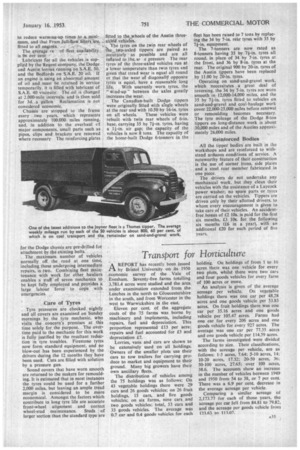Transport for Horticulture A REPORT has recently been issued by Bristol
Page 141

If you've noticed an error in this article please click here to report it so we can fix it.
University on its 1950 economic survey of the Vale of Evesham. Seventy-five farms totalling 3,781.4 acres were studied and the area under examination extended from the Lenches in the north to Gloucestershire in the south, and from Worcester in the west to Warwickshire in the east.
Eleven per cent, of the aggregate costs of the 75 farms was borne by machinery and implements, including repairs, fuel and depreciation. This proportion represented £13 per acre; repairs and fuel accounted for £3 and depreciation £7.
Lorries, vans and cars are shown to be extensively used on all holdings. Owners of the smaller plots use their cars to tow trailers for carrying produce to market and equipment to their ground. Many big growers have their own ancillary fleets.
The distribution of vehicles among the 75 holdings was as follows: On 43 vegetable holdings there were 29 cars and 26 goods vehicles; on 26 fruit holdings, 15 cars, and five goods vehicles; on six farms, nine cars and two goods vehicles; total, 53 ears and 33 goods vehicles. The average was 0.7 car and 0.4 goods vehicles for each holding. On holdings of from I to 10 acres there was one vehicle for every two plots, whilst there were two cars and four goods vehicles for every farm of 100 acres or more.
An analysis is given of the average acreage per vehicle. On vegetable holdings there was one car per 48.28 acres and one goods vehicle per 53.85 acres. On fruit holdings there was one car per 35.16 acres and one goods vehicle per 105.47 acres. Farms had one car for every 206 acres and one goods vehicle for every 927 acres. The average was one car per 77.35 acres and one goods vehicle per 114.59 acres.
The farms investigated were divided according to size. Their classifications, with the acreage per vehicle, are as follows: 1-5 acres, 7.64; 5-10 acres, 14: 10-20 acres, 17.32; 20-50 acres, 36: 50-100 acres, 27.65; over 100 acres, 38.6. The accounts show an increase in the number of vehicles between 1949 and 1950 from 54 to 58, or 7 per cent. There was a 6.9 per cent, decrease in the average acreage per vehicle.
Comparing a similar acreage of 2,17177 for each of those years, the acreage per car fell from 84.81 to 79.82, and the acreage per goods vehicle from 123.63 to 111.07.












































































































































































